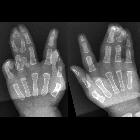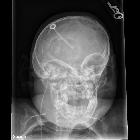syndactyly














Syndactyly (plural: syndactylies) refers to a congenital fusion of two or more digits. It may be confined to soft tissue (soft tissue syndactyly/simple syndactyly) or may involve bone (bony syndactyly/complex syndactyly).
Epidemiology
The overall estimated incidence is at ~1 per 2,500 to 5,000 live births . There may be a greater male predilection.
Pathology
There is a very wide spectrum of syndactyly ranging from partial to complete.
Associations
Syndactyly can occur as an isolated phenomenon or can be associated with numerous other entities. Isolated cases can be either sporadic or familial.
Aneuploidic syndromic
- triploidy: tend to affect the 3 and 4 digits of the hands
Non-aneuploidic syndromic
- acrocephalosyndactylies
- type I: Apert syndrome
- type II: Crouzon syndrome
- type III: Saethre-Chotzen syndrome
- type V: Pfeiffer syndrome
- acrocephalopolysyndactylies
- type I: Noack syndrome
- type II: Carpenter syndrome: typically gives soft tissue syndactyly
- type III: Sakati-Nyhan syndrome
- type IV: Goodman syndrome
- amniotic band syndrome
- Fraser syndrome / cryptophthalmos syndrome
- Gorlin syndrome
- Greig cephalopolysyndactyly syndrome
- macrodystrophia lipomatosa
- Pallister-Hall syndrome
- Poland syndrome
- proximal radioulnar synostoses: Cenani Lenz syndactyly
- prune belly syndrome
- Roberts syndrome
- VACTERL association
- Down syndrome
- neurofibromatosis type 1
Non syndromic
- isolated polydactyly, a.k.a. polysyndactyly
- isolated brachydactyly, a.k.a. brachysyndactyly
- isolated ectrodactyly
Distribution
As a whole the 2 and 3digits tend to be most frequently associated . May involve the toes more than fingers.
Radiographic features
Plain radiograph
Postnatally the type and degree of bony syndactyly can be easily diagnosed on plain film.
Antenatal ultrasound
Often difficult to diagnose on ultrasound (especially with soft tissue syndactyly). The diagnosis may be suggested if the digits appear to constantly move together . The fingers may appear constantly deformed with complex syndactyly .
Treatment and prognosis
The overall prognosis can be extremely variable depending on the presence of other associated anomalies.
History and etymology
The term syndactyly is derived from the Greek words syn meaning together and daktulos meaning fingers.
See also
Siehe auch:
- Polydaktylie
- Brachydaktylie
- Amniotisches-Band-Syndrom
- Gorlin-Goltz-Syndrom
- VACTERL-Assoziation
- Poland-Syndrom
- Apert-Syndrom
- prune belly syndrome
- macrodystrophia lipomatosa
- Roberts-Syndrom
- Crouzon-Syndrom
- Triploidie
- Ektrodaktylie
- Carpenter syndrome
- angeborene Handfehlbildungen
- Pallister-Hall-Syndrom
- Polysyndaktylie
- acrocephalopolysyndactyly
- Fraser-Syndrom
- Tetradaktylie
- Greig-Syndrom
- Cenani Lenz syndactyly
- Noack syndrome
- Goodman syndrome
- Sakati Nyhan syndrome
und weiter:
- Meckel-Syndrom
- cyllosoma
- fetal conditions associated with maternal diabetes
- Mesomelie
- Tibiale Hemimelie
- kongenitale Anomalien der Finger
- acrocephalosyndactyly
- Smith-Lemli-Opitz-Syndrom
- dysencephalia spanchnocystica
- Mesomele Dysplasie
- De-Grouchy-Syndrom Typ 2
- Saethre-Chotzen-Syndrom
- acrocephalopolysyndactyly type II
- acrofacial dyostosis
- Eaton-McKusick-Syndrom
- 7-dehydrocholesterol reductase deficiency
- ectrodactyly-ectrodermal dysplasia-clefting syndrome
- Oligodaktylie
- kongenitale Anomalien der Zehen
- Dubowitz-Syndrom
- Pseudoaminopterin-Syndrom
- Patterson-Stevenson-Fontaine-Syndrom
- high-head syndrome
- Symbrachydaktylie
- Oligosyndaktylie
- central polysyndactyly

 Assoziationen und Differentialdiagnosen zu Syndaktylie:
Assoziationen und Differentialdiagnosen zu Syndaktylie:














